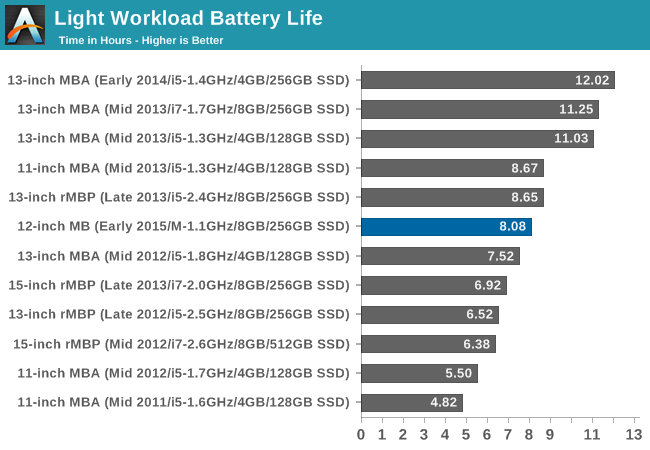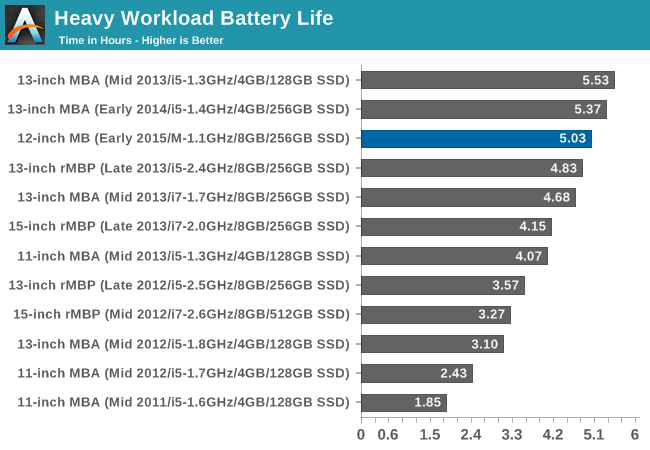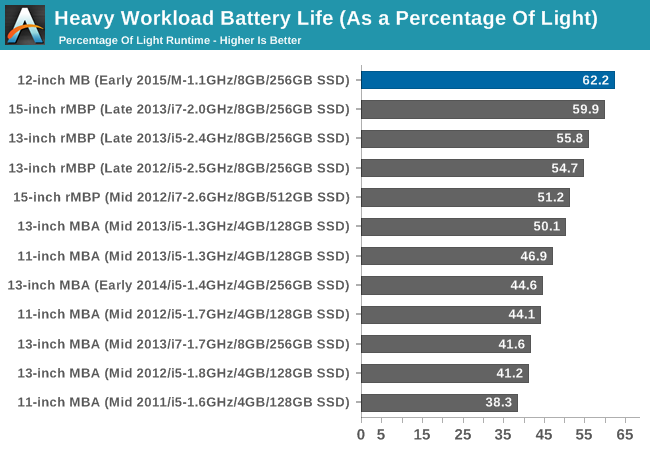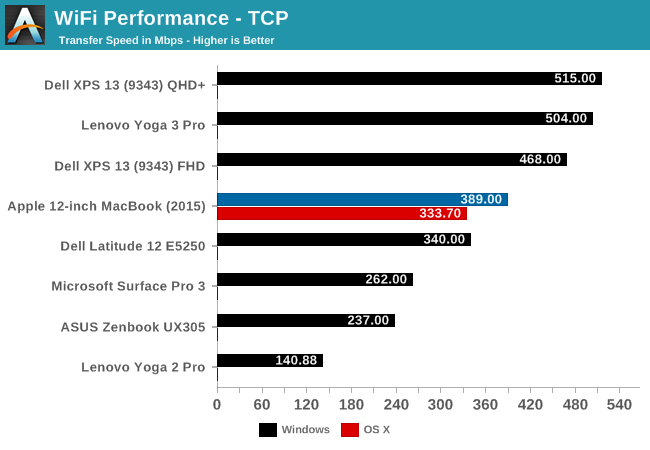The 2015 MacBook Review
by Ryan Smith on April 14, 2015 10:15 AM ESTBattery Life & WiFi Performance
Last but certainly not least in our look at the MacBook is a look at its battery life and WiFi performance.
Along with the technical considerations that have gone into making the MacBook as small as it is, I would consider the subject of battery life to be the second most interesting aspect of the MacBook’s design. For on the one hand, the CPU at the heart of this laptop is Core M, a very low power CPU specifically designed for thin & light devices, which on its own doesn’t draw all that much power. On the other hand in constructing the MacBook Apple has ditched the MacBook Air’s standard DPI TN panels for high DPI Retina IPS panels. As we’ve seen in other Apple products in the past, going Retina incurs a significant power cost, as the high DPI displays require a much stronger, much more power hungry backlight to light up the display. Apple needs only to pay this cost once, but it’s an expensive cost.
All the while Apple also has to deal with the battery capacity limits of such a small chassis. Using terraced batteries has allowed Apple to maximize the amount of volume the MacBook’s batteries occupy, however at 39.7Wh this only gets them up to roughly where the 11” MBA (38Wh) already sat. The end result is that relative to the 11” MacBook Air Apple has virtually the same battery capacity to drive a less power-hungry CPU and logic board paired with a more power-hungry display.
Officially the MacBook should be able to hit 9 hours of runtime on a light web workload, and 10 hours with video playback. This happens to be identical to what the 11” MacBook Air is rated for, and in practice would be very close to what the Haswell-based 11” Airs hit as well.
Meanwhile to test battery life, we have two workloads. Our light test is light web browsing, and our heavy test increases the number of pages loaded, adds a 1 MB/s file download, and has a movie playing. We set all displays to 200 nits.

In practice what we find is that by our testing methodologies the MacBook falls about an hour short, clocking in at 8 hours and 5 minutes. The difference in battery life most likely comes down to differences in how we test; Apple bases their estimates on 75% display brightness, whereas we test at 200 nits, which in the case of the MacBook is around 85% brightness. If we turned our brightness down to 75% I suspect our results would come very close to Apple’s, at the cost of dropping below 200 nits of brightness.
Even by our own testing standards, the MacBook’s battery life is enough to get the laptop through an entire work day (8 hours) – if only just – so while we can’t hit 9 hours at our preferred brightness Apple isn’t in too poor of a position for such a small laptop. In practice what this means is that the MacBook does just a bit worse than the 11” MacBook Air, essentially falling behind by 40 minutes of runtime. However given the fact that the MacBook is also physically smaller than the 11” Air, this is not an unexpected tradeoff.
Putting things in a bit larger perspective, thanks to Intel’s massive energy efficiency gains from Haswell in 2013, the MacBook looks very good compared to the older 2011/2012 11” MacBook Air models. From a battery life perspective the new MacBook easily exceeds those models, is physically smaller than those models, and all the while delivers performance that at worst is equivalent and at best better than those models. Put another way, Apple has been able to hold performance constant while bringing down both the size and greatly improving the battery life.
However if you want better than 8 hours on a light workload, then even the MacBook is no substitute for a larger laptop with a bigger battery. There’s only so much that can be done on 39.7Wh, and as a result the 13” MacBook Air will remain unmatched as Apple’s long-haul Ultrabook.

Meanwhile with a heavy workload the MacBook’s fortunes improve. No longer just in the middle of the pack, at 5 hours and change it’s offering runtimes close behind the 13” MacBook Airs. This shift in relative performance is not unexpected, and is closely tied to the balance between CPU power consumption and display power consumption. Compared to the light workload, the heavy workload requires that the CPU draw quite a bit more power all the while the amount of power drawn by the display is virtually unchanged. As a result the higher powered MacBook Airs see a big step up in their power requirements, while the Core M equipped MacBook sees a smaller step up.

In fact if you look at heavy workload runtime as a percentage of light workload runtime, the 2015 MacBook has the smallest drop in runtime out of all of the MacBooks. Apple’s latest laptop gets 62.2% of its light runtime under the heavy workload, compared to 50.1% for the best MacBook Air. The only thing with a similarly small decrease are the Retina MacBook Pros, whose large, Retina displays result in a similar situation.
Somewhat paradoxically then, the MacBook looks best under a heavy workload, even though its processor is relatively slow. Ultimately this is more an intellectual curiosity than anything else, but it’s a great example of how the MacBook’s component selection has resulted in a much different power consumption balance between the display and CPU than what we’ve seen on the MacBook Airs and similar Ultrabooks. If the display isn’t the single biggest power draw on the MacBook, it’s certainly going to be a close second.
WiFi Performance
Our final benchmark is a quick glance at WiFi performance. The MacBook ships with a Broadcom 2x2:2 802.11ac solution, which means that in theory it is capable of delivering up to 833Mbps.
For our WiFi benchmark we copy a large file from a Gigabit Ethernet connected SMB file server, timing how long it takes to transfer the complete file and calculating the average. All laptops are placed within a few feet of the router to maximize their achievable bandwidth and minimize interference. For the MacBook we’ve gone ahead and run this test under both Windows and OS X, to showcase any performance differences between the two OSes.

Under Windows the MacBook hits 389Mbps, about 47% of its theoretical maximum performance. Compared to other Windows laptops this is a mixed bag, with some laptops able to hit as high as 500Mbps, and others coming up much shorter. In the case of the MacBook I suspect the all-aluminum chassis is not doing it any favors. Meanwhile performance under OS X is a bit worse at 333.7Mbps, most likely due to OS X’s less extensively optimized SMB support.
While I imagine it’s impractical from a design perspective, given the fact that the MacBook only has a single USB port, I would have liked to see a 3x3:3 solution for the MacBook to allow it to achieve better WiFi performance. Even 3x3 solutions seldom keep up with GigE in the real world, but the MacBook certainly has the SSD and processing power to handle faster speeds than what we’re seeing here.










354 Comments
View All Comments
RT81 - Wednesday, April 15, 2015 - link
The presence of "no touch screen" complaints, as few as they are, is interesting. There's a whole demographic of Mac users (creative professionals, mostly) that are sweating bullets about the possibility of iOS and OS X converging. A touch screen Mac would probably give them a heart attack.Apple has said they don't have any intention of doing that. It didn't go over so well for Microsoft, but who knows. It wouldn't be the first time Apple has said "we'll never do that" but what they really mean is "we'll never do that until we can do it at the standard of quality we want".
senzen - Wednesday, April 15, 2015 - link
Very good, thorough review. As soon as I sold my 2010 MBA 11 to get an MBPr Pro I missed the smaller size and weight, but I wanted a retina display for when I travel and take photos, so the new Macbook ticks all the boxes. My doubt was the performance, but seeing it apparently does at least as well as the first i5 MBAs is reassuring, I don't need more. I'm still tempted to wait for the second generation, which is reinforced by Apple's inability to actually show these in stores. I wonder if the upgrade to the faster (less slow) processor is worth it.Malac - Wednesday, April 15, 2015 - link
I think two tests that I feel would be very interesting are missing:- Remote Desktop streaming
- Virtual Machine Benchmark
I sometimes play PC games streamed from my powerful desktop to my MacBook Air using Microsoft Remote Desktop or Steam. While this works well, the air does get hot sometimes and I hear the fans. How would the MacBook handle such a load?
And how well does a VM work? Lets say VirtualBox + Linux with a graphical frontend?
Ryan Smith - Wednesday, April 15, 2015 - link
Steam in-home streaming uses H.264, so all the heavy lifting should be done by the video decode block, and the end result not much harder than decoding any other 1080p60 H.264 stream.jeffry - Wednesday, April 15, 2015 - link
Nice. Apples "new" butterfly mech. Thats a copy of how the japs have done it years ago in their Sony Vaio SZ Series notebooks...nerd1 - Wednesday, April 15, 2015 - link
Why mention tablet laptop crossover at all? This laptop is not convertible, not derachable, lacks touchscreen or pen. It is by all means just a thin, lightweight laptop (with LESS endurance and power)Ryan Smith - Wednesday, April 15, 2015 - link
The short answer is because internally it's built like a tablet, not a laptop, and that's the primary point I'm trying to make when discussing its construction.nerd1 - Thursday, April 16, 2015 - link
Built like a tablet? What does it mean at all? How does crippled laptop becomes a tablet?Some tablets are more powerful and expandable than MBA 11" (which is a LAPTOP).
nerd1 - Wednesday, April 15, 2015 - link
Oh and samsung released very similiar laptop (core m, 1600p display, 2lbs) with usb, sd slot and separate power jack months before.solipsism - Wednesday, April 15, 2015 - link
1) I think it's both odd and wrong that Ryan Smith would repeatedly try to state this is some sort of Mac-iPad hybrid. It doesn't run iOS, it has an attached keyboard and trackpad, it doesn't even have a touchscreen display (something increasingly more common on notebooks). This is a notebook computer designed to run a desktop-grade OS.2) This is not a netbook. Even if we ignore all the low-quality, budget-focused design constraints that that made the netbook really only good* for surfing the "net", this machine has a CPU that costs more than the average notebook and that is magnitudes more powerful with a similar power envelope. If it's to be classed at anything it is an Ultrabook, sans the official branding.
3) Apple's USB-C adapters aren't that pricey. If one wants, they can buy the adapters that Google sells for their new Chromebook Pixel or wait for other vendors (my favourite is Monoprice) to offer up their own solutions since this is, after all, USB. There will also likely be 3rd-party external displays from everyone(?) that will use a single USB-C port for both charging the device and pushing data, which will have their own variety of built-in hubs for those wanting an external display which makes the majority of these complaints for a nascent standard just coming to market moot.
4) People are lamenting the loss of MagSafe, but is that really feasible with how small the 3rd(?) MagSafe adapter would have gotten for this machine? Also, if it's designed to be used remotely and designed to be almost always used without cabled peripherals, is it really an issue for its intended market? Personally, I love how the Chromebook Pixel has USB-C on each side and how either can charge the device. I've moved an entire office around because of how the plug on the left-hand side was causing it to wear out after about 6 months due to being plugged into the wall at the right. This was never an issue when PVC was still included in cables (speculative cause and effect). Hopefully when the MBPs get this feature it will be on both sides.
5) So why bring back the MB and not simply call it the MBA (not unlike how they keep the non-Retina MBPs and came out with the new Retina MBPs with a new design)? Eventually I would like to see the MBA get the exact same external HW design and components (i.e.: Retina display with the same 12" design only) but running Mac OS X — or a Mac OS X-like OS — on Apple's A-series chip. This could allow Apple to move their "PC" sales to even lower end of the market by being able to drop the cost by a few hundred dollars whilst still being able to have a machine that performs well. I do think the A-series chip may need some additional revisions (but we really don't know what is possible with their bespoke design) and for Mac OS X to get another housecleaning, perhaps even rewritten in Swift.
* Calling a netbook good at anything is a stretch, especially when even Adobe Flash would stutter on even 480p video due to its inept HW.